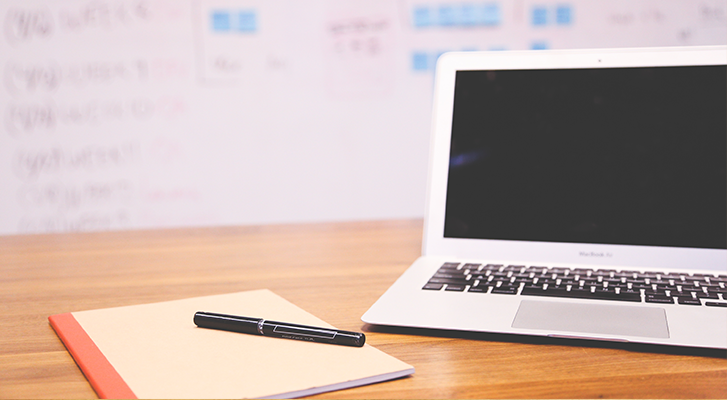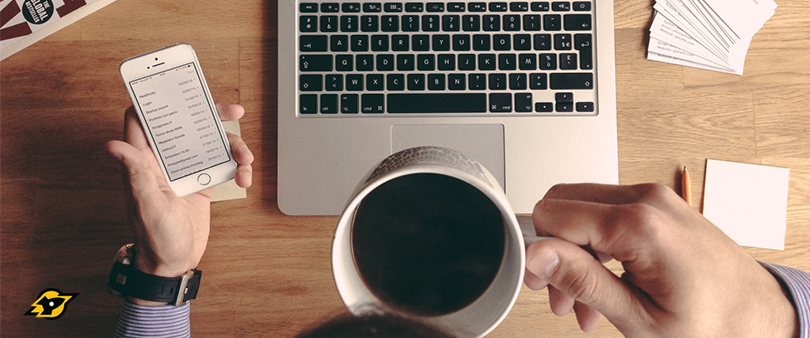Everyone’s pretty much awesome at being productive in a non-specific way — that’s called being busy. It’s being productive in the things that matter that, well, matters. There’s plenty of advice out there on how to be more productive when it comes to the important things, and a lot of that advice is great. But let’s dig a little deeper and look a little farther afield to uncover some of the nuances and uncommon ideas that’ll help you develop a personalized approach to maximum productivity in your design work.
You might also like: 15 Chrome Extensions That Will Make You a More Productive Web Designer
1. Take advantage of tools — but don’t go tool crazy

There are plenty of awesome tools and apps out there to help increase your productivity in various ways, from to-do-list trackers like WorkFlowy to design-focused resources like ProofHQ and UsersThink. There are plenty of smart folks making tools to help you be more productive at all sorts of tasks, so be inquisitive about what’s out there from time to time. Think about what your processes are, then do a search for tools that might help you make those processes more efficient; you may even find a tool that lets you streamline a process you hadn’t considered streamlining. And be sure to, you know, ask other designers, too.
Also keep in mind the “transaction costs” involved in adding a new tool to your toolkit, especially when switching from an existing one. One of the biggest productivity difference-makers I ever implemented was switching to a Dvorak keyboard layout. I can type about 30 WPM faster than I ever could with a regular QWERTY keyboard, and with less wrist strain. But it also took me almost three months to become proficient at it, and there was a tricky transition period where I was lousy at both keyboard layouts. Thankfully, I was in college at the time, so it’s not like I had a lot of papers to write…
Point of the story: You can earn some great dividends by changing up your toolkit, but be aware of the potential costs of switching. If you’re planning on changing to a new prototyping tool because you think it’ll help your team work faster and make your clients happier, make sure to evaluate what the switch from your current prototyping solution is going to involve.
The final trick here is in not letting tools (or the process of trialing them) become a stand-in for true productivity. Scroll through muz.li to spark website design inspiration, but don’t spend hours poring mindlessly over other people’s designs. Background-noise generators are great, but you probably don’t need to spend half a day trialing dozens of different options. Also incorrect: “The wood grain on that sweet Pencil stylus is gonna help me draw soooo much faster than my boring old white plastic stylus does.” It is pretty sweet, though.
2. Design a better workspace

Your work environment is critical to your productivity, so — as customer experience design expert Ben Jordan says — don’t settle when it comes to designing a workspace that works for you. You’re a designer, so make your workspace a reflection of your own personality and aesthetic, and organize it to accommodate your working style.
Here are a few factors to consider as you go about doing this:
-
Color is a fundamental element in any design decision, and the colors of your workspace can be a fundamental element in determining your productivity. Apparently white walls are a productivity killer. Who’da thunk it?
- Don’t get sucked into the “messy artist” myth, or the idea that a perfectly neat workspace is the key to maximum productivity and creativity. There’s probably no magic bullet here, so find what works for you.
- Do you get antsy working in one place or in one position? Sitting vs. standing vs. uh, warrior pose? I sure do. Think about how your working space(s) can accommodate changing your working position throughout the day.
If you work from home, you might have a decent amount of latitude to switch up your work environment and amp up your productivity. If you’re an office denizen, you may have a limited ability to reorganize, but you can still throw some color in your cube (not white!), block out noise with headphones, and occasionally take your work to conference rooms, cafés, or the great outdoors if it helps you focus better.
For some more practical tips for both home and office workers looking to remake their workspace, check out this Lifehack article. And this infographic on the psychology of the office space shares some of the cool perks of working in the offices of tech strongholds like Facebook and Google, which could give you some ideas for tweaking your own working space. Fun fact: It’s also the longest infographic ever created.
You might also like: 15 More Chrome Extensions That Will Increase Your Productivity as a Web Designer
3. Be a biophile

Nature offers a trove of design inspiration. Chances are, you already tap into many of the forms and processes of the natural world to inform your own design ideas. But nature can help crank up your creative mind beyond just providing direct inspiration for your design decisions.
Urban environments are, not surprisingly, pretty mentally taxing. Nature, on the other hand, can help restore balance to an addled brain, and help improve concentration. So go outside for inspiration and alleviation, and get some plants and natural light into your work area if you can. Heck, even just seeing trees through your window or watching a nature video can provide a significant mental boost.
There’s also the question of air quality. Sure, outdoor air may not always be pristine, especially if you live in or near a city. But indoor air ain’t exactly awesome, either. If your workplace affords you some proximity to nature, even if it’s just a park in a busy city, take advantage! Go for a brisk walk during your work breaks and give your brain a clean-air boost.
Finally, it’s probably common knowledge that exercise can help increase productivity by lowering stress and increasing your motivation. But you may not be aware that getting your exercise done in the great outdoors as opposed to inside a sweaty gym has extra benefits. One study of more than 2,000 people in Finland found that exercising in nature was “connected to better emotional well-being.” And there’s that air quality thing again.
4. Don’t marathon. Sprint, then relax

People have different approaches when it comes to working out. Some prefer distance running, while others are into shorter-duration, higher-intensity workouts. But the human brain is a little pickier in terms of how we “work” it. Specifically, it functions best with shorter bouts of intense, focused work interspersed with periods of rest and relaxation.
You’ve probably worked on teams that applied some version of the Scrum methodology, with work efforts broken up into “sprints” that may be as short as one week. At Rocket Code, we embrace a Scrum methodology with our design and development work. The design team has a daily or semi-daily “stand-up” meeting, as does the engineering team, and deliverables for client projects are organized into weekly plans. This allows us to accomplish and deliver as much high-quality work as we can within a specified amount of capacity, and the weekly cadence helps keep the whole team focused and accountable.
Applying this idea of a “sprint” on a smaller scale can help you sustain your energy more efficiently across the day. Think of it like breathing. You don’t take one big breath and try to make it last a whole minute, do you? So why would you do that with your workday? Break up your work periods into 90 to 120 minute chunks, with shorter periods in between to recuperate. One way to think of this is “managing your energy.” And when you do relax between work sprints, be deliberate about it and really relax.
5. Heed common sense and don’t obsess over perfection

There’s so much advice out there about how to be more productive that it’s important to stay reasonable and trust your instincts. Take any productivity tip or rule of thumb with a grain of salt. Here are a few thoughts to chew on:
-
Do you need to be an early bird to extract maximum productivity from your day? Maybe, or maybe not. Maybe you’re just not wired to get up at dawn’s crack. Find your own rhythm: Focus more on getting enough solid Zs, and on working your “good” hours when you are awake.
-
Should you eschew multitasking as much as possible? Sure, shifting repeatedly between tasks that demand a high level of focus can run you into trouble. But, say, keeping one eye on a light task on your main screen while you check for important alerts in Slack in your peripheral vision on your second monitor? Probably just fine.
-
Do you have to work for exactly 90 minutes before you take a break? Maybe 84 or 110 is more your style.
Good enough is sometimes exactly that — good enough. Don’t obsess about filing all your email messages in perfectly curated folders just to get to the vaunted "Inbox Zero." Aiming for perfection, or some aesthetic ideal, isn’t a fast-track to higher productivity.
Aiming for perfection also comes with its own overhead — when you’re seeking to “perfect” something, whether it’s the state of your desk or a new user interface design, you’re spending time and brain cycles, and directing your focus away from potentially more important things. Aiming for the unreachable can be exhausting, yo. Save your energy.
6. Be deliberate

Do things consciously and intentionally. When you do things deliberately, you can better see them not just as tasks, but how they fit as pieces of an overall process that’s serving you and your work. It’s a virtuous cycle: the more you practice becoming more conscious of what you’re doing, the better you’ll get at doing things deliberately. The wonderful thing about being deliberate is it’s a philosophy you can apply to all areas of your work and life.
Be deliberate about really focusing during your work time; be deliberate about taking breaks between those work periods; and be deliberate about spending them in a truly relaxing way. In a previous article on this blog, my colleague Matt Gartland talked about how it’s so important to “eat, sleep, and breathe your design process.” Matt is of course on point when it comes to the power of immersion to help hone your design chops—just don’t forget that it’s also important to make time to actually eat, sleep, and breathe.
Also be deliberate about the tools and new processes you choose to bring into your work orbit, and be conscious of how they’re going to help you get more quality work done (or not!). For instance, if you’re going to get serious about making a to-do list, be deliberate about not just making the list itself, but tracking how well you actually follow up on the items on the list — the research of Kentaro Fujita has shown that this helps improve self-control.
One final, mini insight that definitely helps me be more productive: Check in with yourself. Whether you’re trying to solve a problem on your own with increasing fruitlessness, are stuck for design inspiration, or just need an infusion of social energy, keep tabs on when it’s a good time to step outside of yourself and take a mental break.
Excelsior.









